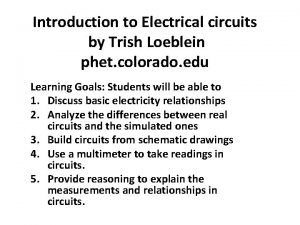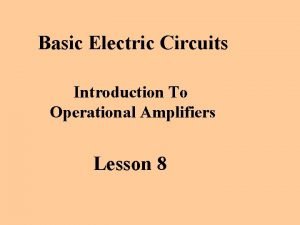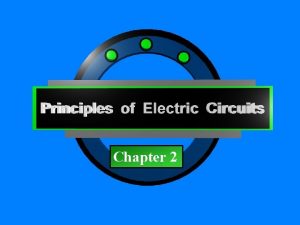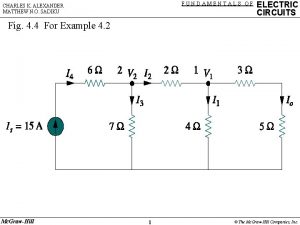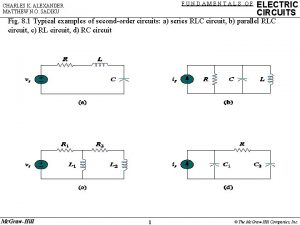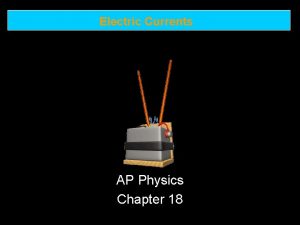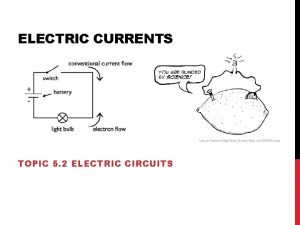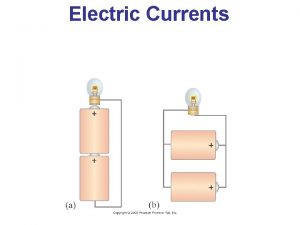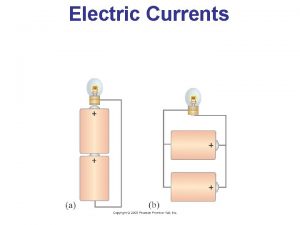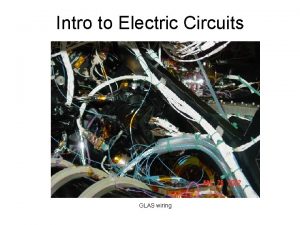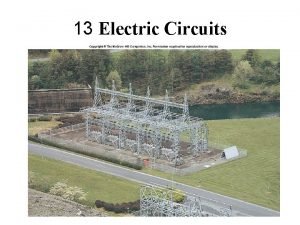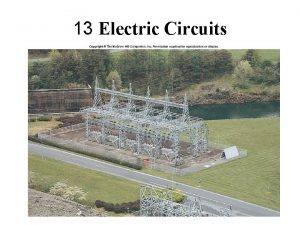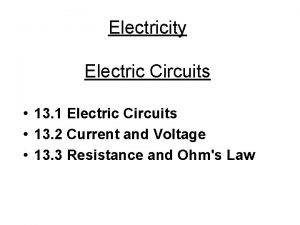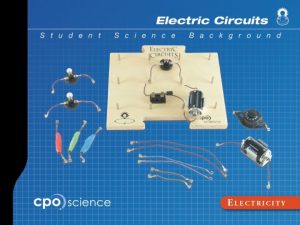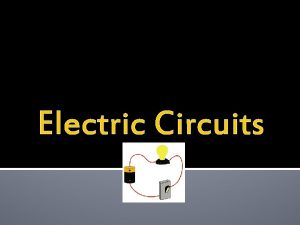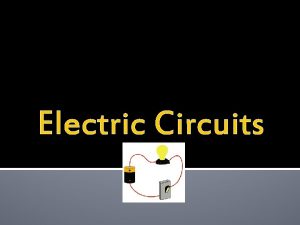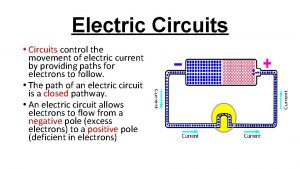Currents CIRCUITS 2 types of electric currents AC



















- Slides: 19

Currents CIRCUITS

2 types of electric currents AC = Alternating current • Electrons in the circuit move in 1 direction for some time and then switch directions and go the opposite way • Ex: household outlets and appliances • DC = Direct current • Charges always flow in the same direction • From negative to positive • Ex: batteries

What is an electric circuit? Any pathway through which electrons can flow/travel + - The bare essentials for a circuit: • battery/power source • Load (lightbulb/lamp) • Wires • A switch to turn it on and off

types of circuit There are two types of electrical circuits; SERIES CIRCUITS PARALLEL CIRCUITS

SERIES CIRCUITS The components are connected end-to-end, one after the other. They make a simple loop for the current to flow round. A break anywhere in the loop will result in an open circuit and no more moving electrons If one bulb ‘blows’ it breaks the whole circuit and all the bulbs go out.

PARALLEL CIRCUITS The components are connected side by side. The current has a choice of routes. If there is a break in one path, it might not affect the other path

circuit diagram Scientists usually draw electric circuits using symbols; cell lamp switch wires

measuring current Electric current is measured in amps (A) using an ammeter which is connected in series in the circuit. A

measuring current SERIES CIRCUIT • current is the same at all points in the circuit. 2 A 2 A 2 A PARALLEL CIRCUIT • current is shared between the components 2 A 2 A 1 A 1 A

Discuss with your neighbor what the missing ammeter readings would be 3 A ? 4 A ? 3 A 1 A ? 4 A ? 4 A 1 A 1 A ?

measuring voltage The ‘electrical push’ which the cell gives to the current is called the voltage. It is measured in volts (V) on a voltmeter which is drawn across (on top of) circuit components V

series circuit • voltage is shared between the components 3 V 1. 5 V

parallel circuit • voltage is the same in all parts of the circuit. 3 V 3 V 3 V

Let’s recap: Series Circuit Current Voltage Parallel Circuit Same Shared Same

measuring current & voltage a) 6 V 4 A A V V A

measuring current & voltage b) 4 A 6 V A V A

measuring resistance in series In series: to find total resistance of a series circuit, add the individual resistances of the objects in series 6 V 3Ω 2Ω The total resistance of this circuit would be 5 Ω

Voltage Drop What happens to voltage as you move past each light? -It drops – we can calculate the “voltage drop” of each light using Ohm’s law After you find the total resistance. Use Ohms Law to calculate the current. 6 V 3Ω 2Ω Then calculate the how the voltage drops across each resistor.

measuring resistance in parallel In parallel, use the following formula to find the total resistance: 6 V 6 V 3Ω RT = R 1 x R 2 = R 1 + R 2 2Ω Total resistance in parallel will always be less than the smallest resistor
 Compared with surface currents deep currents are
Compared with surface currents deep currents are Current in a parallel circuit
Current in a parallel circuit Electric currents and magnetic fields
Electric currents and magnetic fields Visualizing magnetic field
Visualizing magnetic field Phet electric circuits
Phet electric circuits Fundamentals of electric circuits chapter 4 solutions
Fundamentals of electric circuits chapter 4 solutions Electric current
Electric current Conceptual physics chapter 35 electric circuits
Conceptual physics chapter 35 electric circuits Chapter 20 electric circuits
Chapter 20 electric circuits Electric circuits equations
Electric circuits equations The circuit chapter 9
The circuit chapter 9 Fundamentals of electric circuits chapter 7 solutions
Fundamentals of electric circuits chapter 7 solutions Chapter 35 electric circuits answers
Chapter 35 electric circuits answers Electric circuits by james nilsson and susan riedel
Electric circuits by james nilsson and susan riedel Ohm's law worksheet
Ohm's law worksheet Principle of electric circuit
Principle of electric circuit Three elements of a basic program for electrical safety are
Three elements of a basic program for electrical safety are Charles k. alexander matthew n. o. sadiku
Charles k. alexander matthew n. o. sadiku Sadiku
Sadiku Superposition electric circuits
Superposition electric circuits




